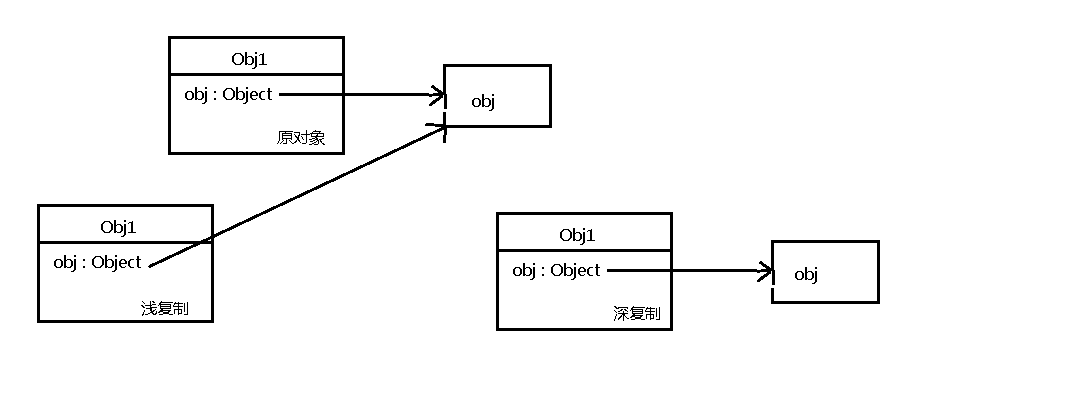1、核心本质:
用原型实例指定创建对象的种类,并且通过拷贝这些原型创建新的对象。
2、应用场景:
-通过new产生一个对象需要非常繁琐的数据准备或访问权限,则可以使用原型模式。
3、原型模式实现:
-Cloneable接口和clone方法(不属于Cloneable接口,是Object类中的方法,通过override该方法实现拷贝)
-Prototype模式中实现起来最困难的地方就是内存复制操作,所幸在java中提供了clone()方法替我们做了绝大部分事情
4、浅复制与深复制的概念
浅复制:复制对象与原对象所有成员变量的值相等,包括引用成员变量(即复制对象与原对象引用成员变量都指向同一个对象)。
深复制:复制对象与原对象所有成员变量(除引用变量外)都相等,虽然引用变量的值不同,但引用变量指向的对象成员数据相等。
代码示例:
/**
* 实体类(实现浅复制)
* @author ly1
*
*/
public class Car1 implements Cloneable,Serializable{
private String name;
private Date cloneDate;
public Car1(String name, Date cloneDate) {
super();
this.name = name;
this.cloneDate = cloneDate;
}
public String getName() {
return name;
}
public void setName(String name) {
this.name = name;
}
public Date getCloneDate() {
return cloneDate;
}
public void setCloneDate(Date cloneDate) {
this.cloneDate = cloneDate;
}
@Override
protected Object clone() throws CloneNotSupportedException {
return super.clone();
}
}/**
* 原型模式(浅复制)
* @author ly1
*
*/
public class Client1 {
public static void main(String[] args) throws Exception {
Date date = new Date(1231312312312L);
Car1 c1 = new Car1("奥迪",date);
Car1 c2 = (Car1) c1.clone();
System.out.println("修改前:");
System.out.println("c1-->date:"+c1.getCloneDate());
System.out.println("c2-->date:"+c2.getCloneDate());
date.setTime(917239817932172L);
System.out.println("修改后:");
System.out.println("c1-->date:"+c1.getCloneDate());
System.out.println("c2-->date:"+c2.getCloneDate());
}
}
结果:
修改前:
c1-->date:Wed Jan 07 15:11:52 CST 2009
c2-->date:Wed Jan 07 15:11:52 CST 2009
修改后:
c1-->date:Fri Mar 04 22:18:52 CST 31036
c2-->date:Fri Mar 04 22:18:52 CST 31036import java.util.Date;
/**
* 实体类(实现深复制)
* @author ly1
*
*/
public class Car2 implements Cloneable{
private String name;
private Date cloneDate;
public Car2(String name, Date cloneDate) {
super();
this.name = name;
this.cloneDate = cloneDate;
}
public String getName() {
return name;
}
public void setName(String name) {
this.name = name;
}
public Date getCloneDate() {
return cloneDate;
}
public void setCloneDate(Date cloneDate) {
this.cloneDate = cloneDate;
}
@Override
protected Object clone() throws CloneNotSupportedException {
//将对象的成员变量(除基本类型和String类型)也都克隆一份,实现深复制
Object clone = super.clone();
Car2 car = (Car2) clone;
car.cloneDate = (Date) this.cloneDate.clone();
return car;
}
}import java.util.Date;
/**
* 原型模式(浅复制)
* @author ly1
*
*/
public class Client2 {
public static void main(String[] args) throws Exception {
Date date = new Date(1231312312312L);
Car2 c1 = new Car2(new String("奥迪"),date);
Car2 c2 = (Car2) c1.clone();
System.out.println("修改前:");
System.out.println("c1-->date:"+c1.getCloneDate());
System.out.println("c2-->date:"+c2.getCloneDate());
date.setTime(917239817932172L);
System.out.println("修改后:");
System.out.println("c1-->date:"+c1.getCloneDate());
//由于实现了深复制,改变对象c1的成员变量,c2的成员变量不改变
System.out.println("c2-->date:"+c2.getCloneDate());
}
}
结果:
修改前:
c1-->date:Wed Jan 07 15:11:52 CST 2009
c2-->date:Wed Jan 07 15:11:52 CST 2009
修改后:
c1-->date:Fri Mar 04 22:18:52 CST 31036
c2-->date:Wed Jan 07 15:11:52 CST 20095、使用序列化与反序列化实现深复制
/**
* 使用序列化和反序列化技术实现深复制
* 要求实体类实现java.io.Serializable接口
* @author ly1
*
*/
public class Client3 {
public static void main(String[] args) throws Exception {
Date date = new Date(12312312L);
Car1 car = new Car1("宝马",date);
//使用序列化和反序列化
ByteArrayOutputStream bos = new ByteArrayOutputStream();
ObjectOutputStream oos = new ObjectOutputStream(bos);
oos.writeObject(car);
byte[] bytes = bos.toByteArray();
oos.flush();
oos.close();
ObjectInputStream ois = new ObjectInputStream(new ByteArrayInputStream(bytes));
Car1 car2 = (Car1) ois.readObject();
ois.close();
System.out.println(car);
System.out.println(car2);
System.out.println("原型:-->date" + car.getCloneDate());
System.out.println("克隆:-->date" + car2.getCloneDate());
System.out.println("修改前:");
System.out.println("c1-->date:"+car.getCloneDate());
System.out.println("c2-->date:"+car2.getCloneDate());
date.setTime(917239817932172L);
System.out.println("修改后:");
System.out.println("c1-->date:"+car.getCloneDate());
System.out.println("c2-->date:"+car2.getCloneDate());
}
}
结果:
Prototype.Car1@8ea9cf1
Prototype.Car1@729f624a
原型:-->dateThu Jan 01 11:25:12 CST 1970
克隆:-->dateThu Jan 01 11:25:12 CST 1970
修改前:
c1-->date:Thu Jan 01 11:25:12 CST 1970
c2-->date:Thu Jan 01 11:25:12 CST 1970
修改后:
c1-->date:Fri Mar 04 22:18:52 CST 31036
c2-->date:Thu Jan 01 11:25:12 CST 19706、new方式与clone方式效率对比
/**
* 测试new方式和clone()方式(原型模式)的效率
* @author ly1
*
*/
public class Client4 {
public static void testNew(){
long start = System.currentTimeMillis();
for (int i = 0; i < 1000; i++) {
Rocket r = new Rocket();
}
long end = System.currentTimeMillis();
System.out.println("new方式耗时:"+(end - start)+"ms");
}
public static void testClone() throws Exception{
Rocket r = new Rocket();
long start = System.currentTimeMillis();
for (int i = 0; i < 1000; i++) {
Rocket r1 = (Rocket) r.clone();
}
long end = System.currentTimeMillis();
System.out.println("clone方式耗时:"+(end - start)+"ms");
}
public static void main(String[] args) throws Exception {
testNew();
testClone();
}
}
class Rocket implements Cloneable{
public Rocket(){
try {
Thread.sleep(10); //线程休眠10ms,模拟创建对象耗时现象
} catch (InterruptedException e) {
e.printStackTrace();
}
}
@Override
protected Object clone() throws CloneNotSupportedException {
return super.clone();
}
}
结果:
new方式耗时:10093ms
clone方式耗时:0ms分析:
-很显然clone方式快得多,直接从内存复制。
-如果创建对象很耗时,可以采用原型模式。























 3800
3800

 被折叠的 条评论
为什么被折叠?
被折叠的 条评论
为什么被折叠?








